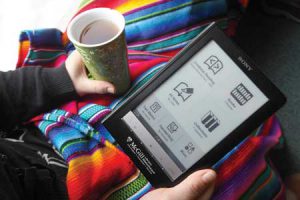
By Tamarah Feder
Wow, we have come a looooong way since cave paintings, the schlepping of stone tablets, papyrus rolling and unrolling, the printing press and Etch-a-Sketching.
Full disclosure: When it comes to technology, I’m what you might call a throwback. OK, a Luddite. Whatever. And when it comes to reading a well-written story, the feel of smooth, durable, acid-free, perfectly toned creamy white pages that balance just the right dose of ink into painstakingly designed fonts are soothing. I even like the smell of old, yellowing books. I have a paperback book of A Man, by Oriana Fallaci, that is held together with yellowing tape and elastics. I love how some books are works of art in their production, textures and dimensions. Printers are as much a dedicated and artistic breed as those who write and design books.
Then, about four years ago, I got to hold an electronic thingamabob the size and weight of a skinny paperback that could hold the equivalent of a gazillion pounds of books. And I was smitten. “So let me understand: This little thing can carry ALL my books ALL the time and not only will I not suffer a lopsided shoulder, I won’t get any paper cuts either?”
Sure, the technophobic naysayers sound compelling. “You can’t cuddle with electronics,” they whine. “Not natural,” some kvetch. “I hate reading from my computer so what makes you think this would be any fun?” one bellyached. “It will never take off.” they harrumphed in unison.
But really, the only way to be sure is to try one out and, thanks to McGill’s libraries’ broad efforts to expand services to students, faculty and staff, I did. I borrowed one of the more than 100 Sony e-readers that display pdf and epub files (epub files are best because they re-flow when you change font size and most publishers are going that way). I’ve got to say, I really like the thing. Sure, after being introduced barely a year ago, there are newer flashier models, but I was blown away by how easy this one is to use, and how much I enjoyed reading from it.
Using the McGill Overdrive online library, I gave in to a guilty pleasure and borrowed two Steig Larsson books. I loved that I could read the overwritten tomes totaling more than 1,000 pages anywhere. No more cramps between my thumb and forefinger from trying to keep a heavy book open while lying in bed. I could read when my eyes got tired because I could make the font HUGE. If I wanted to mark up the book (and I did … because “everybody’s an editor”), I could use the stylus, write notes in the margins, highlight paragraphs or add more thorough notes – handwritten or typed – on a separate “sheet” and then export it onto my computer. I can even listen to MP3s on it.
When I fell asleep reading, I never lost my page. It always knew where we had left off. And because McGill’s e-readers come automatically plugged in with more than 100 classics in French and English, when I finished my books, I still had a good 50 pounds of other books at the ready.
Thankfully, I don’t think we are anywhere near losing books in their original form. As vinyl records experience a renaissance in spite of iTunes, I have faith books will survive, too. After all, it’s so nice to go to someone’s house and look at what they have on their bookshelves. Rummaging through bookstore offerings can fill a need I didn’t even know I had. And a book that falls into a lavender bubble bath can dry off, even if a little curlier.
But it is nice to have the option.
Check out the video demonstrations of McGill’s e-readers by going to the Libraries website (www.mcgill.ca/library). Have questions? Ask Maria Savova, the McGill Libraries Liaison or try the e-chat option (www.mcgill.ca/library/library-assistance/askus).
